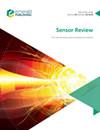A novel hand-eye calibration method for industrial robot and line laser vision sensor
IF 1.4
4区 工程技术
Q3 INSTRUMENTS & INSTRUMENTATION
引用次数: 0
Abstract
Purpose The purpose of this study is solving the hand–eye calibration issue for line structured light vision sensor. Only after hand–eye calibration the sensor measurement data can be applied to robot system. Design/methodology/approach In this paper, the hand–eye calibration methods are studied, respectively, for eye-in-hand and eye-to-hand. Firstly, the coordinates of the target point in robot system are obtained by tool centre point (TCP), then the robot is controlled to make the sensor measure the target point in multiple poses and the measurement data and pose data are obtained; finally, the sum of squared calibration errors is minimized by the least square method. Furthermore, the missing vector in the process of solving the transformation matrix is obtained by vector operation, and the complete matrix is obtained. Findings On this basis, the sensor measurement data can be easily and accurately converted to the robot coordinate system by matrix operation. Originality/value This method has no special requirement for robot pose control, and its calibration process is fast and efficient, with high precision and has practical popularized value.一种新的工业机器人手眼标定方法及线激光视觉传感器
目的解决线结构光视觉传感器的手眼标定问题。传感器的测量数据只有经过手眼标定后才能应用到机器人系统中。设计/方法/方法本文分别研究了眼对手和眼对手的手眼标定方法。首先通过刀具中心点(TCP)获取机器人系统中目标点的坐标,然后控制机器人使传感器对目标点进行多姿态测量,获得测量数据和姿态数据;最后,采用最小二乘法最小化标定误差平方和。通过向量运算得到变换矩阵求解过程中缺失的向量,得到完整的矩阵。在此基础上,通过矩阵运算可以方便、准确地将传感器测量数据转换为机器人坐标系。独创性/价值该方法对机器人姿态控制无特殊要求,标定过程快速高效,精度高,具有实用推广价值。
本文章由计算机程序翻译,如有差异,请以英文原文为准。
求助全文
约1分钟内获得全文
求助全文
来源期刊

Sensor Review
工程技术-仪器仪表
CiteScore
3.40
自引率
6.20%
发文量
50
审稿时长
3.7 months
期刊介绍:
Sensor Review publishes peer reviewed state-of-the-art articles and specially commissioned technology reviews. Each issue of this multidisciplinary journal includes high quality original content covering all aspects of sensors and their applications, and reflecting the most interesting and strategically important research and development activities from around the world. Because of this, readers can stay at the very forefront of high technology sensor developments.
Emphasis is placed on detailed independent regular and review articles identifying the full range of sensors currently available for specific applications, as well as highlighting those areas of technology showing great potential for the future. The journal encourages authors to consider the practical and social implications of their articles.
All articles undergo a rigorous double-blind peer review process which involves an initial assessment of suitability of an article for the journal followed by sending it to, at least two reviewers in the field if deemed suitable.
Sensor Review’s coverage includes, but is not restricted to:
Mechanical sensors – position, displacement, proximity, velocity, acceleration, vibration, force, torque, pressure, and flow sensors
Electric and magnetic sensors – resistance, inductive, capacitive, piezoelectric, eddy-current, electromagnetic, photoelectric, and thermoelectric sensors
Temperature sensors, infrared sensors, humidity sensors
Optical, electro-optical and fibre-optic sensors and systems, photonic sensors
Biosensors, wearable and implantable sensors and systems, immunosensors
Gas and chemical sensors and systems, polymer sensors
Acoustic and ultrasonic sensors
Haptic sensors and devices
Smart and intelligent sensors and systems
Nanosensors, NEMS, MEMS, and BioMEMS
Quantum sensors
Sensor systems: sensor data fusion, signals, processing and interfacing, signal conditioning.
 求助内容:
求助内容: 应助结果提醒方式:
应助结果提醒方式:


